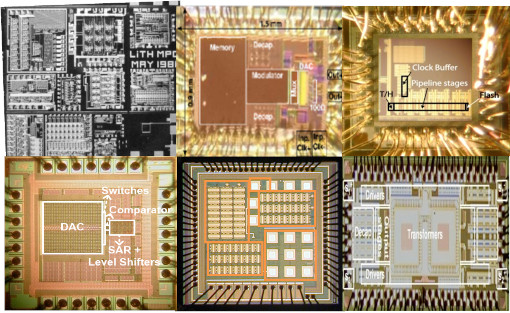Research under the auspices of the ELLIIT collaboration into circuit design for 5G and 6G networks is now leading the world. Linköping University is home to a Swedish centre of expertise for both energy-efficient and lightning-fast integrated circuits and less rapid circuits with extremely low energy consumption.
We are in the vanguard of research in IC design, which means that our students and doctoral students have knowledge that is equally advanced. Together with our collaboration partners at Lund University, we provide expertise to Ericsson and other industrial actors in the field”, says Atila Alvandpour, professor in the Integrated Circuits and Systems Division, Linköping University.
Research groups in Linköping and Lund started work in the field at an early stage when the first rules for chip design started to appear in the scientific literature towards the end of the 1970s. At the time, 20,000 transistors could be manufactured on a single chip, and the first textbook in IC design was published by American researchers Lynn Conway and Carver Mead in 1979.The first courses in chip design in the Nordic region, and probably also in Europe, were held in the spring of 1981 at Linköping University, and research here has led the world ever since.
The ELLIIT collaboration in recent years between groups in Lund and Linköping has been important for the development of, for example, Ericsson’s new base stations for the 5G network and the development of high data rate and energy-efficient electronic circuits to convert analogue to digital signals and vice versa. Such converters are necessary for the traffic between mobile phones and base stations. High data rate and energy efficient radio circuits are also critical requirements for 5G and 6G technology.
“Today, we are in the front line when it comes to high-speed, low-power circuits for 5G and 6G”, says Atila Alvandpour.
“The new antenna technology for 5G and 6G known as “massive MIMO” uses arrays of radio links that are connected to individual small antennas with a very high data rate, which leads to high power consumption. Since there are so many circuits, each tiny increase in energy efficiency has a profound effect on the overall result. Today, we are in the front line when it comes to high-speed, low-power circuits for 5G and 6G”, says Atila Alvandpour.
Another important line in circuit design research is prominent at Linköping University – circuits with extremely low power consumption, some of which can even harvest energy, for use in medical applications.

“These circuits are not particularly fast, but they don’t have to be. Here the key challenge is to arrive at extremely low power consumption. We are working in collaboration with medical researchers at Karolinska Institutet, and other sites. We have developed circuits for pacemakers that harvest energy from heartbeats, and in the most recent project we have developed circuits for sensors that monitor the cells in the pancreas that produce insulin. Here, we can contribute to more effective medicines to treat diabetes”, says Atila Alvandpour.
Atila Alvandpour and his group at LiU are also coordinators for the centre of expertise in integrated circuits and systems within the Swedish strategic innovation programme Electronic Components and Systems financed by Vinnova, the Swedish Energy Agency and Formas. Within this Swedish centre of expertise, new collaborations are continuously being established between small and large Swedish companies and researchers at Swedish universities and research institutes.
Research Group
Research
Atila Alvandpour, professor, Christer Svensson, professor emeritus, and Ted Johansson, adjunct professor, Division of Integrated Circuits and Systems, Department of Electrical Engineering, Linköping University. Six doctoral students, four of whom have defended their dissertations during their work.

